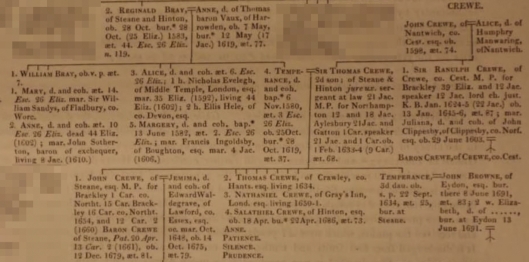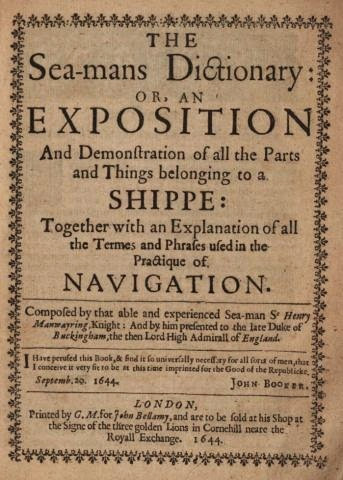My 11th great grandmother was Temperance Crew nee Bray (abt 1580 – 1619). She was the wife of Sir Thomas Crew (1564 – 1634), a lawyer and politician. His entry in the History of Parliament online mentions his marriage to her, noting that she was the daughter of Reynold Bray of Steane and a kinswoman of the 7th Earl of Shrewsbury, Gilbert Talbot (1552 – 1616). Temperance, her father who died in 1583, and her and Thomas’s son John, are also mentioned in her husband’s entry in the Dictionary of National Biography.
Temperance was the fourth of five daughters of Sir Reginald (or Reynold) Bray (c. 1550 – 1583) and his wife Anne Bray nee Vaux (c. 1550 – 1619). She was baptised on 6 November 1580 at Hinton in the Hedges, Northamptonshire.
Reginald Bray died in October 1583 and was buried at Hinton in the Hedges on 18 October 1583. Reginald was aged about 44.
An inquisition post mortem was held (Esc. 26 Eliz. n. 119.) This was a local enquiry into the lands of a deceased person, held to discover what income and rights were due to the crown. Information from this inquisition was used to produce a family tree by George Baker in his 1822 book History and Antiquities of the County of Northampton (page 685).

Reginald had one son, William, who died in his father’s lifetime aged about 7. Reginald had five daughters who were his coheirs:
- Mary, aged 14 in 1583 thus born about 1569. On 16 August 1586 at Eaton Bray, Bedfordshire, she married Sir William Sandys (c 1562 – 1641) of Fladbury, Worcestershire. She appears to have died by 1597 about which time Sir William Sandys married secondly to Margaret Culpepper. She appears not to have had children.
- Anne, aged 10 in 1583 thus born about 1573; she was later the wife of John Sotherton (1562 – 1631), a judge and later a Baron of the Exchequer. John Sotherton married two more times and had two sons and a number of daughters – it is not certain if Anne was the mother of these children. Anne had died by 1602.
- Alice, aged 6 in 1583 thus born about 1577. In 1592 she married Nicholas Eveleigh, a lawyer. Nicholas Eveleigh died aged 56 in 1618 when the Chagford Stannary Courthouse collapsed killing him, two of his clerks and seven others, also leaving a further 17 injured. She secondly married Elize (Ellis) Hele, a lawyer and philanthropist who died in 1635. The trust from his will was used to found a number of schools including Pympton Grammar School. Alice died on 20 June 1635, it would seem she had no children. She and her second husband are buried at Exeter Cathedral but there is a monument to both of her husbands at Bovey Tracey Church.
- Temperance, aged 3 in 1583 (see below)
- Margery, age 2 in 1583 thus born about 1581. She married Francis Ingoldsby of Boughton and they had a son John.

The chancel of Bovey Tracey Church, Devon looking eastward. On the left (north) side , the monument with effigy of Nicholas Eveleigh (d.1618); on the south side the monument with effigy of Elize Hele (d.1635), who married Eveleigh’s widow Alice Bray. Photograph by Wikimedia commons user Lobsterthermidor [CC BY-SA 3.0], retrieved from Wikimedia Commons

Effigy in Bovey Tracey Church, Devon, of Nicholas Eveleigh (d.1618) of Parke in the parish of Bovey Tracey. Photograph from Wikimedia Commons by user Lobsterthermidor [CC BY-SA 3.0]

Monument to Elize Hele in Bovey Tracy Church, Devon. Below his effigy are the kneeling effigies of his two wives, facing each other in prayer, behind the left one kneels his young son. Photograph from Wikimedia Commons by user Lobsterthermidor [CC BY-SA 3.0]
Thomas Crew was first elected to Parliament in 1604 representing Lichfield.
Temperance and Thomas had nine children:
- John Crew (1598 – 1679)
- My 10th great grandfather. Married Jemima Waldegrave and had six sons and two daughters. Was a Member of Parliament and was mentioned in the diaries of Samuel Pepys.
- Anne Crew (1599 – ?)
- married Sir Edward Stephens, a Member of Parliament. They had three sons and a daughter
- Thomas Crew (abt 1602 – after 1682)
- Attended Queen’s College, Oxford: matriculated 1618, BA 1622, MA 1625.
- Nathaniel Crew (abt 1606 – 1692)
- Attended Lincoln College, Oxford, matriculated 1623. Admitted Gray’s Inn January 1622.
- Patience Crew (abt 1608 – 1642)
- Patience married Sir John Curzon (1598 – 1686), a Member of Parliament. They had seven children. Patience and John are buried at Kedleston, Derbyshire.

Memorial to Sir John Curzon, All Saints’ Church, South Transept, Kedleston Photograph from Geograph.org.uk
- Temperance Crew (abt 1609 – 1634)
- Temperance married John Browne (c 1608 – 1691) and died without having children. She is memorialised at Steane. In June 1660 Samuel Pepys recorded in his diary that he went to visit Mrs Browne. The 2000 edition published by University of California Press has annotated that Mrs Browne was Elizabeth, second wife of John Browne, Clerk of the Parliaments: his first wife (d. 1634) was Temperance Crew, aunt of Montagu’s wife.
- Silence Crew (abt 1611 – 1651)
- Silence married Sir Robert Parkhurst (1603 – 1651) of Pyrford, Surrey, Member of Parliament. They had one son.
- Salathiel Crew (1612 – 1686)
- Attended Lincoln College, Oxford, matriculated 25 November 1631. Was a soldier. In 1641 there was a Certificate of residence showing Salathiel Crew (or the variant surname: Crewe) to be liable for taxation in Northamptonshire, and not in the half-hundred of Newport, Buckinghamshire, the previous area of tax liability. Salathiell Crew was appointed sherif of Rutland in 1652. Salathiel Crew was buried at Hinton in the Hedges. His will mentions his brother Thomas and two granddaughters, Isabella and Elizabeth. I have found no record of Salathiel’s marriage, children or military career other than the mention of militis in Oxford University Alumni.
- Prudence Crew (1615 – 1641)
- Prudence Crewe died unmarried in 1641. She left a will probated 10 June 1641.
Temperance Crewe died in 1619.
Sir Thomas rebuilt the chapel of St Peter at Steane in memory of his wife who was buried there and an altar Tomb bears her figure and that of Sir Thomas dressed in his Sergeants robes.On a tablet is this inscription:
“Temperans Crewe, the wife of Thomas Crewe, esq. And one of the daughters and coheirs of Reginald Bray, esq. By his wife Anne, his wife, daughter of Thomas Lord Vaux, died in the year of our Lord 25 October, 1619, in the year 38 of her age, and now restith from her labours, and hir works follow hir:
A daughter of Abraham here doth lye
Returned to her dust
Whole life was hid in Christ with God
In whom was all her trust
Who wifely wrought while it was day
And in hir spirit did watch and pray
To heare God’s word attentive was her care
Hir humble hart was full of holy feare
Hir hande which had good blood in every vaine
Yet was not dayntye nor did disdayne
Salve to applye to Lazarus fore
And was inlarged to the poore
Lyke God’s Angells she honor’d those
That taught his word and did his will disclose
And persons vile her hart abhor’d
But reverenst such as fear’d the Lord
A true Temperans in deed and name
Now gone to heaven from whence she came
Who with her lott was well contented
Who lived desired and dyed lamented.
Premissa non amissa, discessa non mortua
Conjux casta, parens foelix, matrona pudica,
Sara vivo, mundo Martha, Maria deo.”
[Having never lost, went out without having died, = Not lost, but gone before
A chaste wife, a happy parent, a modest lady,
A living Sara, a worldly Martha, Maria of god.]
Photographs of the chapel and the monument can be seen by clicking the links below:
Thomas Crew served as speaker of the House of Commons from 1623 – 1625. Thomas Crew was knighted in 1623.
To the end of his life Sir Thomas Crew continued to practice law.

Portrait of Sir Thomas Crewe, Speaker 1623 – 1625. Given by his descendant Ralph Cartwright, Esq. 1805. In the collection of the UK Parliament (catalogue number WOA 2702) Crew displeased James 1 by upholding the liberties of Parliament as ‘matters of inheritance, not of grace’ but later said by the King to be the ‘ablest Speaker known for years’.
Crewe died on 1 Feb. 1634, aged 68, and was buried with his wife under the marble effigy in the chapel he had built at Steane. His funeral sermon praised the quickness of his wit, the firmness of his memory, and the readiness of his expression. He was said to be one who ‘set the stamp of religion on all his courses, in his whole conversation’, ‘a man exceeding conscionable’, ‘a marvellous great encourager of honest, laborious, religious ministers’, ‘the poor man’s lawyer’, and ‘a great lover of his country’.
Sources
- Archive.org
- Family tree of Reginald Bray retrieved from Baker, George. “History and Antiquities of the County of Northampton.” 1822, page 685 retrieved electronically through Archive.org archive.org/stream/HistoryAndAntiquitiesOfTheCountyOfNorthamptonBakerVol1/History%20and%20Antiquities%20of%20the%20County%20of%20Northampton%20-%20Baker%20Vol%201#page/n687/mode/2up.
- Ingalsbe, Frederick W. “Ingoldsby Genealogy, Ingoldsby, Ingalsbe, Ingelsby and Englesby, from the 13th Century to 1904 ” Archive.org, archive.org/details/ingoldsbygenealo00inga/page/8.
- Philipot, John. “The Visitation of the County of Buckingham Made in 1634 by John Philipot, Esq. .” Archive.org, College of Arms, 1909, archive.org/details/visitationofcoun58phil/page/76.
- History of Parliament online
- British History online : ‘House of Commons Journal Volume 7: 12 November 1652’, in Journal of the House of Commons: Volume 7, 1651-1660 (London, 1802), pp. 214-215. British History Online http://www.british-history.ac.uk/commons-jrnl/vol7/pp214-215
- Google books
- William Cotton (1859). Some account of the ancient borough town of Plympton St. Maurice, or Plympton Earl. With memoirs of the Reynolds family. John Russell Smith. pp. 28–29.
- George Lipscomb (1847). The History and Antiquities of the County of Buckingham. J. & W. Robins. p. 169.
- Samuel Pepys (30 July 2000). The Diary of Samuel Pepys, Vol. 1: 1660. University of California Press. p. 177. ISBN 978-0-520-22579-4.
- The Gentleman’s Magazine (London, England). F. Jefferies. 1790. p. 420. (Monument at Stean in honour of Temperance Crew nee Bray)
- England; John Britton (1810). The beauties of England and Wales; or, Delineations… of each county, by J. Britton and E. W. Brayley [and others]. 18 vols. [in 21]. pp. 83–5.
- National Archives (UK)
- Chancery: Inquisitions post mortem: Bray, Reginald: Northampt. Esc. 26 Eliz. n. 119. Reference C 142/204/119
- Certificate of residence showing Salathiel Crew (or the variant surname: Crewe) to be liable for taxation in Northamptonshire, and not in the half-hundred of Newport, Buckinghamshire, the previous area of tax liability. Reference E 115/112/113
- ancestry.com
- England, Select marriages ,1538 – 1973
- Wills probated in the Prerogative Court of Canterbury
- Dictionary of National Biography (UK)
- Wikipedia: links in text
























